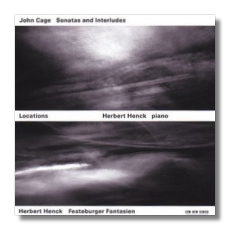
The Internet's Premier Classical Music Source
Related Links
- Latest Reviews
- More Reviews
-
By Composer
-
Collections
DVD & Blu-ray
Books
Concert Reviews
Articles/Interviews
Software
Audio
Search Amazon
Recommended Links
Site News
 CD Review
CD Review
Cage / Henck

Piano Works
- John Cage: Sonatas and Interludes for Prepared Piano
- Herbert Henck: Festeburger Fantasien
Herbert Henck, piano and prepared piano
ECM New Series 1842/43 472828-2 DDD 2CDs 66:13, 77:58
When John Cage inserted various nuts, bolts, screws, erasers, and other objects between the strings of an unsuspecting piano, perversity was not his motive. He was simply trying to approximate – frugally – the sound of an Asian percussion ensemble. He wrote, "Composing for the prepared piano is not a criticism of the instrument. I'm only being practical."
One of the first complete performances of all sixteen Sonatas and four Interludes was given in 1949 by Swiss-born pianist Maro Ajemian. One year later, she recorded them for Dial Records. (The label is long defunct, but the recording has been reissued by CRI.) Cage advised other pianists to hear Ajemian's version before attempting their own. Since then, about a dozen pianists have recorded this music. I haven't heard all of the recordings, but there's not a dog in the lot, as far as I know. Cage accepted and even embraced the fact that no two sets of preparations and no two pianos would sound the same. As a result, performances and recordings differ not just in terms of tempo and interpretation, but also in terms of timbre. For collectors who are concerned with authenticity, it should be noted that Philip Vandré (Mode) uses the Steinway "O" piano, the same model Cage used while composing this work, while Aleck Karis (Bridge) uses "period" hardware between his piano's strings! Henck's preparations and performance are completely satisfactory. His tempos are sometimes slower, sometimes faster than Ajemian's, but the engineering is much more modern, of course, and he has an excellent feeling for Cage's gently driving rhythms and his sensuous sonorities.
The second CD is a fascinating portrait of the pianist as a composer/improviser. The Festeburg Fantasies (named for the church in which they were recorded) are unusual in that more than half of them are double-layered improvisations. Henck would improvise one layer, and then through multi-track recording, he would lay a second layer of improvisation over the first. Both prepared and "unprepared" pianos were made available to Henck. The prepared piano used in the Cage sessions was left unmodified for Henck's improvisations, giving him an opportunity for recreation, if you will, after hours spent attending to the rigors of Cage.
Henck creates fantastic timbres and sonorities, and the improvisations run the emotional gamut from bejeweled tenderness to strident brutality. Often I found myself thinking of what Ravel's piano pieces might have sounded like, had Ravel written them under the influence of crystal meth and LSD. The multi-tracking creates thick textures, and so affinities with Conlon Nancarrow's works for player piano can be noted as well. Henck's technique for producing ultra-athletic glissandos ("by hand" as it were – that is to say, without the benefit of any machinery) intensifies the similarities with Nancarrow's music.
The two discs complement each other nicely, just as pieces within both Cage's and Henck's cycles complement each other internally. One of Cage's inspirations was Richard Lippold's sculpture Gemini, a structure comprised of two similar but not identical halves arranged as if they were near-mirror images of each other. (One is reminded, also, of Morton Feldman's fondness for the "crippled symmetries" that he found in the patterns of Asian rugs.)
Many collectors will acquire this set (which, rather mysteriously, has been given the name Locations) for the Cage, and they will not be disappointed. These same collectors, however, should stick around for the Henck. The Festeburg Fantasies will stretch their ears and broaden their horizons. Speaking of locations, the engineering creates a lovely sense of space.
Copyright © 2003, Raymond Tuttle


















